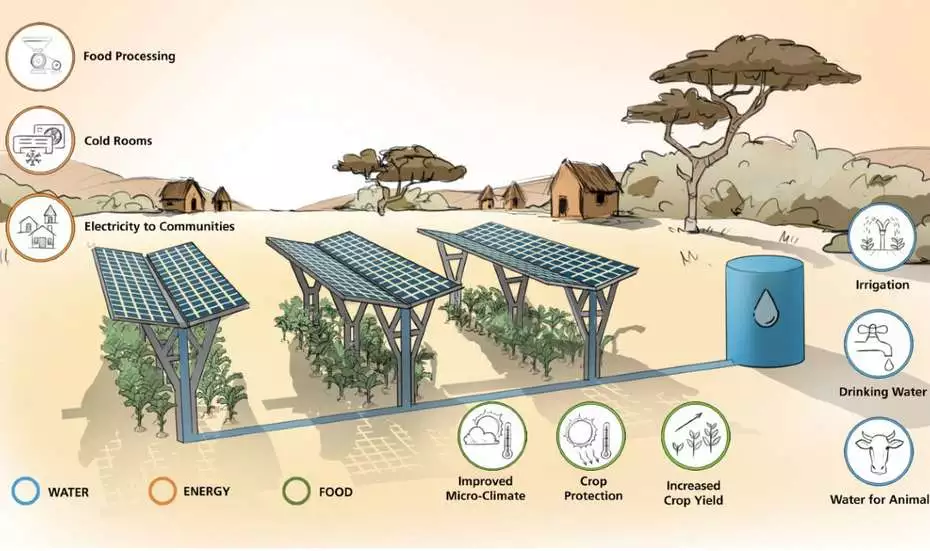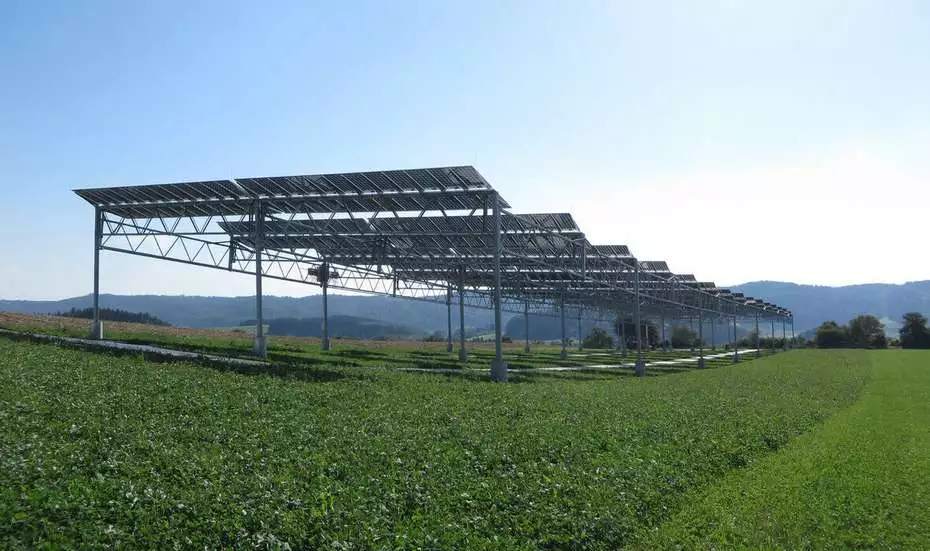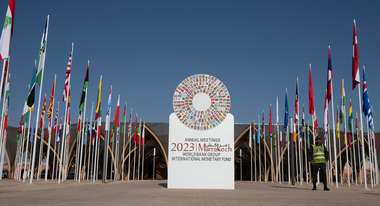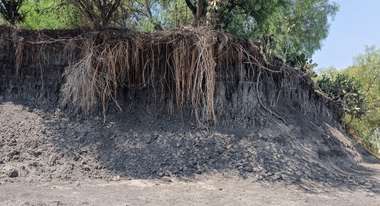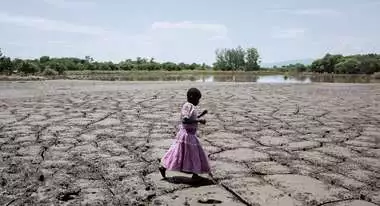Decentralized and with triple benefit – the potential of agrivoltaics in sub-Saharan Africa
New projects in Mali and The Gambia aim to combine solar power with agriculture – merging the management of food, energy and water.
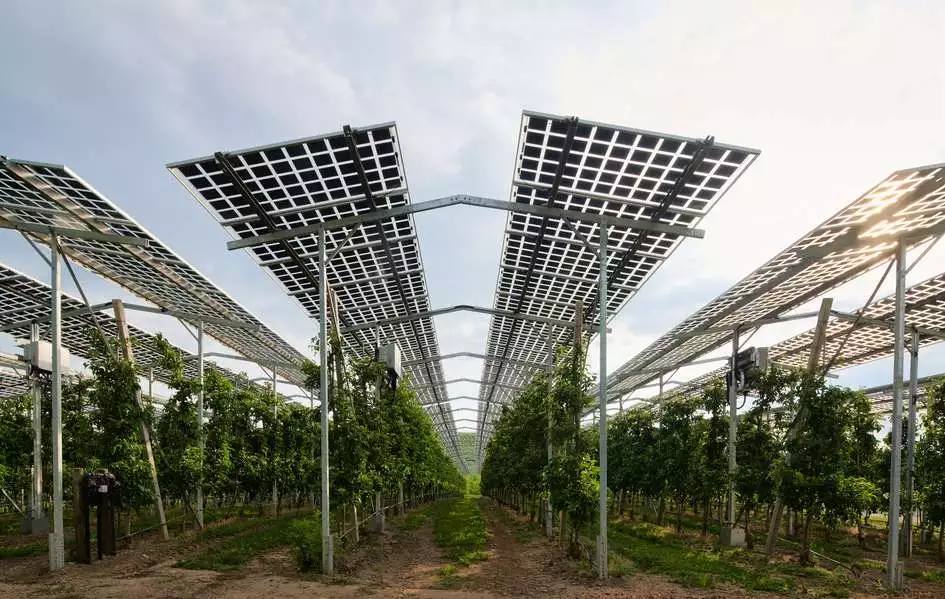
Africa’s potential for renewable energy (RE) generation, especially solar photovoltaics (solar PV) is tremendous. But despite this, the penetration of solar power in the energy sector is still low. Furthermore, the challenges faced across the African continent in the context of the Water-Energy-Food (WEF) Nexus require innovative solutions that maximize the output along agricultural, energy, water, and economic value chains. One solar PV approach that is seen to have the potential to address the challenges within the WEF Nexus and has gained traction in the last decade, is agrivoltaics.
Agrivoltaics enables dual or even triple land-use, through simultaneous use of land for both agriculture and solar photovoltaic power generation, and the potential incorporation of water management solutions into the infrastructure. PV panels are mounted on a substructure on the agricultural land and generate sustainable electricity, while agriculture production takes place underneath or between the PV module rows. In overhead agrophotovoltaic (APV) systems, PV modules are elevated, allowing enough room for agricultural activity below while providing the additional benefit of shading and physical protection to crops and soils, potentially increasing crop yield and quality. Further, the contribution of APV to each component of the WEF nexus has the potential to increase agriculture’s resilience against climate change.
Project Background
The implementation of agrivoltaic research projects in Germany, France, the USA and Japan, and the results and data gathered, have prompted researchers and renewable energy developers to turn their attention to other regions of the world where the potential benefits and opportunities could be even more significant. With that in mind, the project “Agrophotovoltaics for Mali and The Gambia: Sustainable Electricity Production by Integrated Food, Energy and Water Systems” (APV-MaGa) was initiated with the goal of exploring the potential of agrivoltaics within the hot, semi-arid/arid conditions in West Africa.
APV-MaGa is a research and development project focusing on and exploring the potential, the economic and technical feasibility of agrivoltaics in Mali and The Gambia. The project, supported by the German Federal Ministry of Education and Research (BMBF) in the framework program Research for Sustainable Development (FONA 3), aims at improving productivity, efficiency, energy sustainability, and the resilience of the agriculture sector against climate change, by establishing agrivoltaic systems that provide food, water, and electricity [1].
To date the agrivoltaic installations have not yet been installed in either country. The project initially planned to construct one 200-kilowatt-peak (kWp) system in Mali and four smaller systems, up to 62.5 kWp, in The Gambia, by the end of 2022. This has now been shifted to the end of 2023 and the first quarter of 2024, respectively. In Mali the system will be installed in the grounds of the Rural Polytechnic Institute of Training and Applied Research in Katibougou, while the systems in The Gambia are intended to be set up at the University of The Gambia, a small private farm and two community farm sites. The change in installation timeline is described as one of the challenges faced by such systems in Mali and The Gambia.
The crops selected to be cultivated within the agrivoltaic systems were decided upon based on a combination of (1) previous research results on the response of crops to shading and the potential to introduce high economic crops that had not previously been widely cultivated (e.g. strawberry, broccoli) and (2) the desire to maintain the crops already grown at the universities and communities (e.g. onions, tomatoes, potatoes, okra and green beans), so as not to disrupt agricultural practices and therefore be able to assess the impact of agrivoltaics on existing agricultural practices.
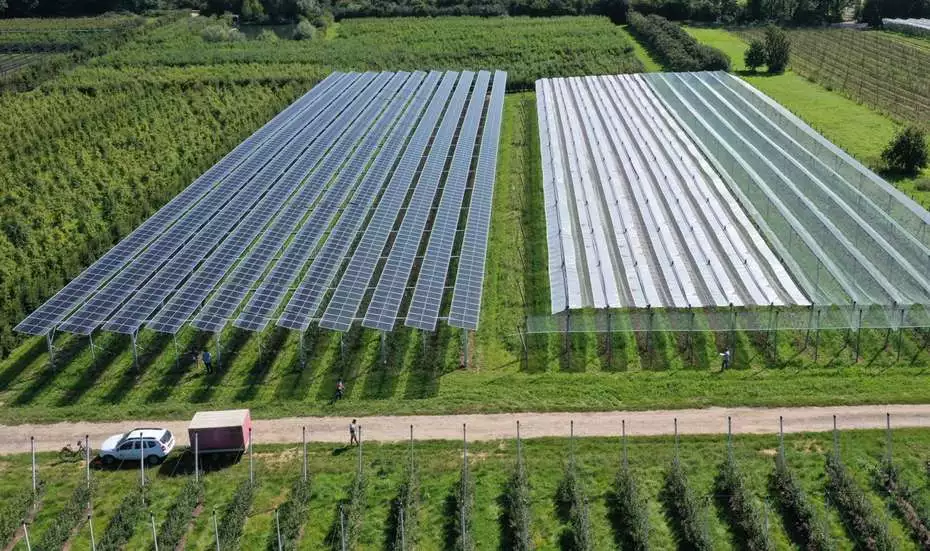
Challenges faced and Potential for Agrivoltaics in Mali and The Gambia
In both target countries, challenges are being faced in each area of the Water-Energy-Food Security Nexus.
Water: Approximately 84 % of the farmland in Mali has water-related constraints [2]. In The Gambia, due to the country’s topography, there is a significant marine influence while the river’s high seasonality and salinity have consequences on land use, productivity and livelihoods. Reduction in the freshwater flow into the River Gambia has increased saltwater intrusion into the estuary and its adjacent forest and agricultural lands. In both countries, the reduction of groundwater recharge systems has also resulted in falling water levels and reduced water columns in wells and boreholes. Changes in rainfall and temperature have already begun to constrain agricultural productivity in both countries.
Energy: Access to energy is a major problem in Mali. Most households in rural areas satisfy their energy needs by using kerosene and batteries, which are expensive and unreliable [3]. In The Gambia, 55% of the overall population does not have access to electricity and only 10% have access to clean cooking facilities. The countries are largely dependent on fossil fuel for electricity generation and developing new local and renewable resources is critical to meeting their economic objectives [4].
Food: Agriculture is increasingly facing major problems due to climate change. Water shortages, extreme weather and increasing global temperatures require new measures to protect plants and the soil against negative environmental influences.
Potential Agronomic Benefits
Given the contribution of agrivoltaics to each component of the Water-Energy-Food Nexus, the benefits are diverse and there is great potential, especially in the hot semi-arid and arid climates in Mali and The Gambia.
Water
Generally, agrivoltaics can alter the microclimate below the panels (reduce air and soil temperatures). As a result, there are less water losses through evaporation and transpiration reducing water requirements of crops. Conservative estimations vary between 10 to 30 % less irrigation requirements[5]. Further, agrivoltaic structures can facilitate rainwater harvest, which has been already implemented on a pilot system in Algeria [6]. In water scarce regions in Mali and The Gambia especially, this could be a major source of irrigation water and might reduce dependency on groundwater or other external water supplies. The energy generated by the agrivoltaic system can in turn be used to facilitate irrigation systems, such as drip irrigation, to maximize crop yields below the panels. This would reduce the costs of irrigation drastically and could allow growing crops in areas usually not suited for agriculture.
Energy
In rural, off-grid locations, agrivoltaics can provide access to electricity and thereby improve energy security. The solar electricity can be used directly for self-consumption on the farms, lowering the costs associated with use of alternative forms of energy (e.g. diesel generators), or used to provide energy services and thereby increasing income diversity. The approach provides energy for productive uses at farm level such as pumping water, operating labor-saving small-scale machinery, raising poultry and producing fodder (chaff cutters), etc., as well as for value-adding processes (grinding, rice milling, drying, packaging, threshing, and ensuring effective cold storage facilities for storing perishable goods). Therefore, agrivoltaics offers the chance to bring energy solutions and climate change adaptations to rural communities and meanwhile strengthening inclusive agri-value chains that would benefit farmers as well as energy producers
Agriculture
Crop temperature stress reduction: In hot climates, the shaded conditions provided by the PV modules of agrivoltaics systems reduce the temperature underneath during daytime, while keeping temperatures constant or somewhat higher during nighttime. In both countries, where heat stress is a common problem, the crops could benefit from the shade provided by the PV modules, which could result in improved crop quality and yield.
Avoidance of sun scorching: During dry months of the year with high solar irradiation and lack of adequate availability of water, crops might become prone to sun scorching where leaves and fruits get damaged due to high exposure to solar radiation. Severe losses can occur both in yield and economic value of the products due to sun scorching.
Land-use efficiency and crop productivity : The simultaneous use of land can increase the land use efficiency by up to 84% depending on the crop[7]. It is thus a resource-efficient way of improving land productivity [8,9]. Crops within agrivoltaic systems tend to spread their leaves more to capture more sunlight thus making them wider than crops exposed to excessive sunlight. This can have a positive impact on the quality and increase crop productivity. Additionally, the PV modules provide physical protection from the elements (for example, heavy rainfall and hail).
Challenges and possible policy implications
While there is an obvious need to improve energy access, and a significant role can be played by renewable energy, there are numerous existing and potential challenges to the deployment of RE and agrivoltaics in particular. As the APV-MaGa project is a research project, supported by majority public and minority private funding, the challenges may not be typical of those faced by fully private funded projects. However, several of the experiences and challenges faced during the implementation of this project may be faced in non-research RE projects.
Project specific challenge
The shift in the installation timeline project has faced several unforeseen challenges, mainly related to the ambitious goal of receiving 50% funding for the demonstrators from local companies (private sector) in each country; the formation of a Special Purpose Vehicle (SPV) to operate and maintain the infrastructure and associated businesses (e.g. a “Pay-as-you-store” – for the store of crops in the coldroom at the community site) and other administrative issues.
Technical and cost challenges
Although solar PV technology is well established, challenges still exist from the procurement phase to the operation and management of the system. One of the main barriers to acceptance and large-scale deployment of agrivoltaics in both Mali and The Gambia is the higher capital expenditure (CAPEX) resulting from the increased material use in the mounting structures, especially in overhead systems. Overall, challenges with procurement of materials and components, logistics, high transport costs and security, further exacerbate cost challenges that are faced. Subsequently, higher capital expenditure as well as risks have the potential knock-on effect of discouraging investment, further hindering acceptance and deployment [10].
Policy
According to Power Africa [11] there are three main bottlenecks facing Mali's energy sector: Utility’s unreliability, unstable grid network and an insecure, unstable governance. The uncertainty within the management of the energy sector is also reinforced by its many participants [12]. The involvement of many ministries, departments and other actors also requires many legal texts and regulations which are sometimes difficult to implement and poorly communicated between these institutions. Many of the same bottlenecks are faced in The Gambia.
To encourage deployment of agrivoltaics and to make investment more attractive in both countries, similar policies and regulatory changes to those implemented in the “first-movers” in agrivoltaics (Japan, the United States, China, France, Italy and Germany) could be explored. Policies and framework conditions could include (1) a set of mandates stipulating the procedure and conditions to permit farmland conversion for agrivoltaic use e.g. maintaining certain crop production output ;(2)maintaining agricultural subsidies on farmland with agrivoltaics installed; (3) the implementation of a Feed-in-Tariff (and possibly a Feed-in-Premium for agrivoltaics) that enables a reasonable payback period / return on investment.
Despite the potential of agrivoltaics in Mali and The Gambia, certain realities are faced and still have to be overcome. The higher CAPEX, installation and maintenance challenges as well as the uncertainty of crop response to the shading (as not all crops respond positively to shading and changes in micro-climate) are some of the main concerns. However, despite these, agrivoltaics has a role to play in the transition to renewables in both target countries and across the continent in general and should be part of a renewable energy portfolio containing diverse strategies and technologies.

References/ Further Reading:
[1] https://www.bmbf-client.de/en/projects/apv-maga
[3] African Development Bank Group (2015) Renewable Energy in Africa: Mali Country Profile. www.afdb.org/fileadmin/uploads/afdb/Documents/Generic-Documents/Profil_ER_Mal_Web_light.pdf (Accessed on the 08.07.2023)
[4] www.iea.org/countries/gambia
[5] Agrivoltaics: Opportunities for Agriculture and the Energy Transition (fraunhofer.de)
[6] https://www.watermed-project.eu/
[7] Fraunhofer ISE, “Agrivoltaics: Opportunities for Agriculture and the Energy Transition,” 2020.
[8] Elamri Y, Cheviron B, Lopez J-M, Dejean C, Belaud G, “Water budget and crop mod-elling for agrivoltaic systems: application to irrigated lettuces,” Agricultural Water Management, No. 208, 2018, pp. 440–453. https://www.sciencedirect.com/sci-ence/article/abs/pii/S0378377418309545.
[9] B. Valle, T. Simonneau, F. Sourd, P. Pechier, P. Hamard, T. Frisson et al., “Increasing the total productivity of a land by combining mobile photovoltaic panels and food crops,” Applied Energy, Vol. 206, 2017, pp. 1495–1507. doi:10.1016/j.apen-ergy.2017.09.113.
[10] Cheo AE, Adelhardt N, Krieger T, et al. Agrivoltaics across the Water-Energy-Food-Nexus in Africa: Opportunities and Challenges for Rural Communities in Mali. Research Square; 2022. DOI: 10.21203/rs.3.rs-1503422/v1
[11] Power Africa. (2018) Mali Factsheet. Retrieved from: https://www.usaid.gov/sites/default/files/documents/1860/Mali_Fact_Sheet_Power_Africa.pdf).
[12] Diarra, D.-C.; Akuffo, F. O. (2002): Solar photovoltaic in Mali: potential and constraints. In: Energy Conversion & Management (43), S. 151–163.
